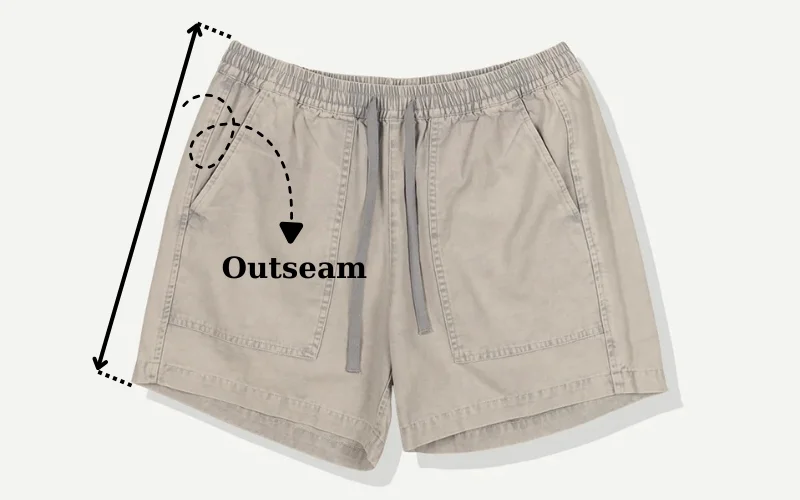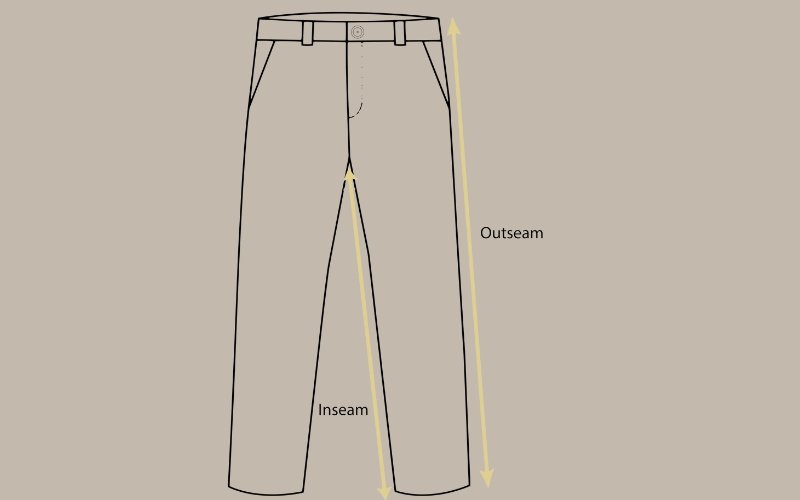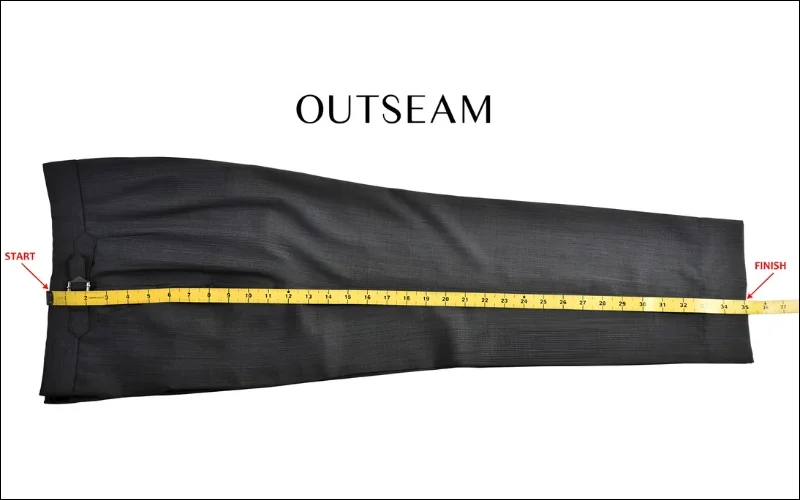Outseam Measurement: A Practical Guide for Businesses
Unlock accurate sizing for your apparel business by mastering the outseam measurement. This essential guide explains this crucial garment dimension, defining it as the total external side length and highlighting its vital difference from the inseam. Understand why precise outseam data is non-negotiable for achieving consistent fit, drastically reducing costly e-commerce returns, and building essential customer trust and brand reputation. Learn the definitive step-by-step technique for accurate measurement on flat garments, avoiding common pitfalls that lead to sizing errors. Effectively apply this knowledge to create reliable size charts and enhance product descriptions, ensuring customer satisfaction.
1. Decoding the outseam: More than just a garment dimension
1.1 Defining the outseam measurement
The outseam measurement refers to the length taken along the exterior edge of a pant or short leg. This vertical clothing measurement runs from the absolute top edge of the waistband straight down to the absolute bottom edge of the hem. Essentially, the outseam represents the total external length of the garment’s leg portion. This specific pants measurement is crucial for various types of bottoms, including trousers, jeans, shorts, and casual pants, providing a clear definition of the garment’s overall side length.

1.2 Locating the outseam on pants and shorts
To find the outseam, identify the very top edge of the waistband – include the entire band in your starting point. From there, follow the line down the outermost side of the leg until you reach the very bottom edge of the leg opening, known as the hem. This outer leg measurement path follows the side of the garment, irrespective of whether a visible seam exists there. This measurement method, sometimes referred to as the side seam length, applies equally to both pants and shorts.
2. Why accurate outseam measurements are crucial for your success
2.1 Ensuring proper fit and customer satisfaction
The outseam measurement directly influences how long pants or shorts will look and feel on the customer. A correctly measured outseam contributes significantly to the overall drape and perceived clothing fit. When product listings feature accurate measurements, potential buyers gain confidence in their purchase decisions. This attention to detail in sizing translates directly into higher customer satisfaction upon receiving the garment, aligning expectations with reality and improving the overall apparel fit experience.
2.2 Reducing costly returns in e-commerce
A primary pain point for online shopping, especially for clothing, is the high rate of returns. Incorrect sizing, particularly discrepancies in length often stemming from inaccurate or misunderstood outseam measurements, is a major contributor to these clothing returns. Each return incurs costs – return shipping fees, inspection and restocking labor, and potentially lost sales if the item cannot be resold quickly or at full price. Providing precise outseam details serves as a proactive measure, helping to minimize these costly returns in e-commerce.
2.3 Building trust and brand reputation
Consistently providing accurate sizing information, including reliable outseam measurements, is fundamental to building customer trust. When customers receive garments that match the described dimensions, their confidence in the brand grows. This reliability fosters positive reviews, encourages repeat purchases, and strengthens the overall brand reputation. For clothing businesses, demonstrating dependability through accurate measurements signals quality and care, setting them apart in a competitive market.
3. Outseam vs. inseam: Clearing up the confusion for accurate sizing
3.1 Defining the inseam measurement
Distinct from the outseam, the inseam measurement focuses on the inner leg length. This measurement is taken along the inside seam of the pant leg, starting precisely at the crotch point – where the front and back seams intersect – and extending down to the very bottom edge of the hem. While crucial for pant sizing and trouser measurement, the inseam primarily informs the fit through the leg itself, rather than indicating the garment’s total external length from the waist.
3.2 Key differences summarized (comparison aspect)
Understanding the distinction between outseam vs. inseam is essential. Here’s a quick comparison:
| Feature | Outseam | Inseam |
|---|---|---|
| Measurement point start | Absolute top of the waistband | Crotch point (where leg seams meet) |
| Measurement point end | Absolute bottom of the hem | Absolute bottom of the hem |
| Measurement path | Along the outer edge of the leg | Along the inner seam of the leg |
| Typical length | Longer than inseam (includes rise) | Shorter than outseam (excludes rise) |
| Key influence | Overall garment length, how high it sits | Fit through the leg, leg length relative to crotch |
The primary reason the outseam is generally longer is that it encompasses the rise area (the distance from the waistband down to the crotch point) in addition to the leg length.

3.3 Why using the correct measurement (outseam or inseam) matters
Precision in using “outseam” and “inseam” in product descriptions and sizing charts is paramount for accuracy. Confusing these two clothing dimensions directly contributes to fit issues, leading inevitably to customer frustration and increased returns. Utilizing the correct term ensures clarity; use the outseam when communicating the total side length of the garment and the inseam when specifying the length from the crotch down, often referenced in a jean fit guide. Accurate terminology prevents misunderstandings and supports a smoother purchasing process.
4. How to measure outseam accurately: A step-by-step guide
4.1 Essential tools: Measuring tape
To measure the outseam correctly, the primary tool needed is a flexible measuring tape, often referred to as a soft tape measure or tailor’s tape. Avoid using rigid metal tape measures or standard rulers, as they cannot accurately conform to the natural lines and curves of the garment. A flexible tape ensures precision when following the outer leg path. These are standard tools for garment measurement.
4.2 Preparing the garment (pants or shorts)
Begin the preparation by laying the garment flat on a clean, flat surface, such as a large table. It is crucial to smooth wrinkles and any folds completely, paying special attention to the waistband area and the path along the outer leg seam. Buttoning or zipping the garment beforehand can help ensure it lies as flat and naturally as possible, preventing measurement inaccuracies.
4.3 The measurement process: Waistband top to hem bottom
Follow these steps for an accurate how to measure outseam procedure:
- Align the ‘zero’ mark of the flexible measuring tape precisely with the waistband top edge, right where the exterior side or side seam begins.
- Carefully run the tape straight down along the outer edge of the pant or short leg, following its natural line towards the hem bottom.
- Ensure the tape measure is held taut – straight and flat against the fabric, without any slack – but avoid stretching the material itself.
- Read the measurement exactly where the tape measure meets the very bottom edge of the leg opening or hem.
- Record the measurement clearly, noting the units used (e.g., inches or centimeters) to ensure consistency for your size charts and product descriptions. This represents the pant length via the outseam.

5. Avoiding common pitfalls in outseam measurement
5.1 Incorrect starting/stopping points (waistband/hem)
One of the most frequent mistakes involves the starting point and stopping point of the measurement. Ensure the tape measure begins precisely at the very top edge of the waistband, not below it. Similarly, the measurement must extend to the absolute bottom edge of the hem, not stopping short. Failing to capture this complete length leads to significant measurement errors and misrepresents the garment’s true external length.
5.2 Not laying the garment completely flat
Proper garment preparation is critical for measurement accuracy. If the pants or shorts have wrinkles, bunching, or are not laid perfectly flat on the surface, the path the measuring tape follows will be distorted. This distortion almost always results in an inaccurate reading, often shorter than the actual outseam. Always smooth the garment meticulously before measuring.
5.3 Allowing slack in the measuring tape
Maintaining correct tape measure tension is crucial. If the tape measure has slack or is allowed to sag away from the garment surface while measuring, the recorded length will be longer than the true outseam. The tape must lie flat and straight along the measurement path. Pull it taut enough to remove any slack, but not so tight that it stretches the fabric, to ensure an accurate measurement.
6. Outseam considerations: Style, rise, and fabric impact
6.1 How pant rise affects outseam length and fit perception
The pant rise – essentially the distance from the crotch seam up to the top of the waistband – plays a significant role in the outseam measurement and how a garment fits. Consider two pairs of pants designed for the same leg length (identical inseams). A high-rise pair will inherently have a longer outseam measurement than a low-rise or mid-rise pair. This outseam length variation occurs because the outseam measurement includes the rise dimension. This difference directly impacts the fit perception, determining where the waist position sits on the body (higher or lower) and influencing the overall silhouette and style.

6.2 Outseam relevance across different pant and short styles
The outseam measurement is a relevant specification for nearly all types of bottom wear, including jeans, trousers, chinos, various styles of shorts, joggers, and more. While the measurement technique remains consistent, the desired leg length indicated by the outseam often shows style-specific variance. For instance, formal trousers typically require a longer, specific outseam for a proper break over the shoe, whereas the ideal outseam for shorts can vary widely based on trend and design (e.g., Bermuda vs. cutoff styles – consult a short length guide for specifics). Understanding outseam helps define the intended length across all these pants and shorts categories.
6.3 Brief note on fabric stretch and measurement
A point regarding garment materials: when dealing with items made from fabrics with significant fabric stretch (like elastane blends often found in jeans or activewear), exercise caution during measurement. Avoid pulling or stretching these stretchy materials while laying them flat or running the tape measure along the outseam. Doing so will distort the resting dimensions and lead to inaccurate readings. Always measure stretch fabrics in a relaxed, flat state to ensure measurement consistency.
7. Related questions
7.1 Is outseam the same as total length?
For pants and shorts, the outseam measurement generally serves as the indicator for the total external length measured along the side. While “total length” could technically be interpreted in other ways, the outseam is the standard industry measurement used to define this specific dimension from the top of the waistband to the bottom hem along the outer leg.
7.2 How much longer is the outseam compared to the inseam?
There is no fixed number or percentage difference between the outseam and inseam; the variance depends entirely on the garment’s rise (the distance from the crotch point up to the top of the waistband). The difference in length between the outseam and the inseam essentially is the rise measurement. Therefore, a high-rise pant will have a much larger difference between outseam and inseam compared to a low-rise pant, even if the inseam (leg length from crotch down) is identical.
7.3 Should I measure outseam on the body or on the garment?
For creating accurate size charts and ensuring consistency for customers comparing garments, measuring the outseam directly on the garment laid flat is the recommended method. This approach provides a standardized measurement that directly corresponds to the product specifications. Measuring the outseam on a person’s body is possible but presents challenges. Achieving accuracy requires precise placement of the tape measure from the natural waist or desired waistband position down the side of the leg, which can be difficult to standardize and often requires assistance. Since size charts refer to garment dimensions, measuring a well-fitting garment owned by the customer or measuring the product itself provides the most reliable comparison point for e-commerce.
7.4 Does the outseam measurement change after washing?
Potential changes in outseam length after washing depend heavily on the garment’s fabric composition. Natural fibers, particularly cotton and denim, are prone to shrinkage, especially during the first few washes and drying cycles. This shrinkage can indeed shorten the outseam measurement slightly. Businesses using fabrics known to shrink should consider this factor, perhaps by conducting wash tests on samples or advising customers about potential changes in the care instructions or sizing information provided.
Read more:
This guide provides a comprehensive summary of the outseam measurement. Key takeaways include understanding its definition (the total external side length), its crucial difference from the inseam, and mastering the steps for accurate measurement. Implementing precise outseam data translates directly into tangible benefits for clothing businesses.
Providing accurate sizing leads to a better fit for customers, significantly boosting customer satisfaction and reducing the frequency of costly returns. Furthermore, consistent accuracy builds brand trust and strengthens reputation.
Integrating reliable outseam measurement practices into your workflow is a strategic step towards sustainable business growth. For clear, professional labels and tags that accurately reflect these crucial sizing details, exploring specialized providers can ensure your commitment to quality is communicated effectively.






















